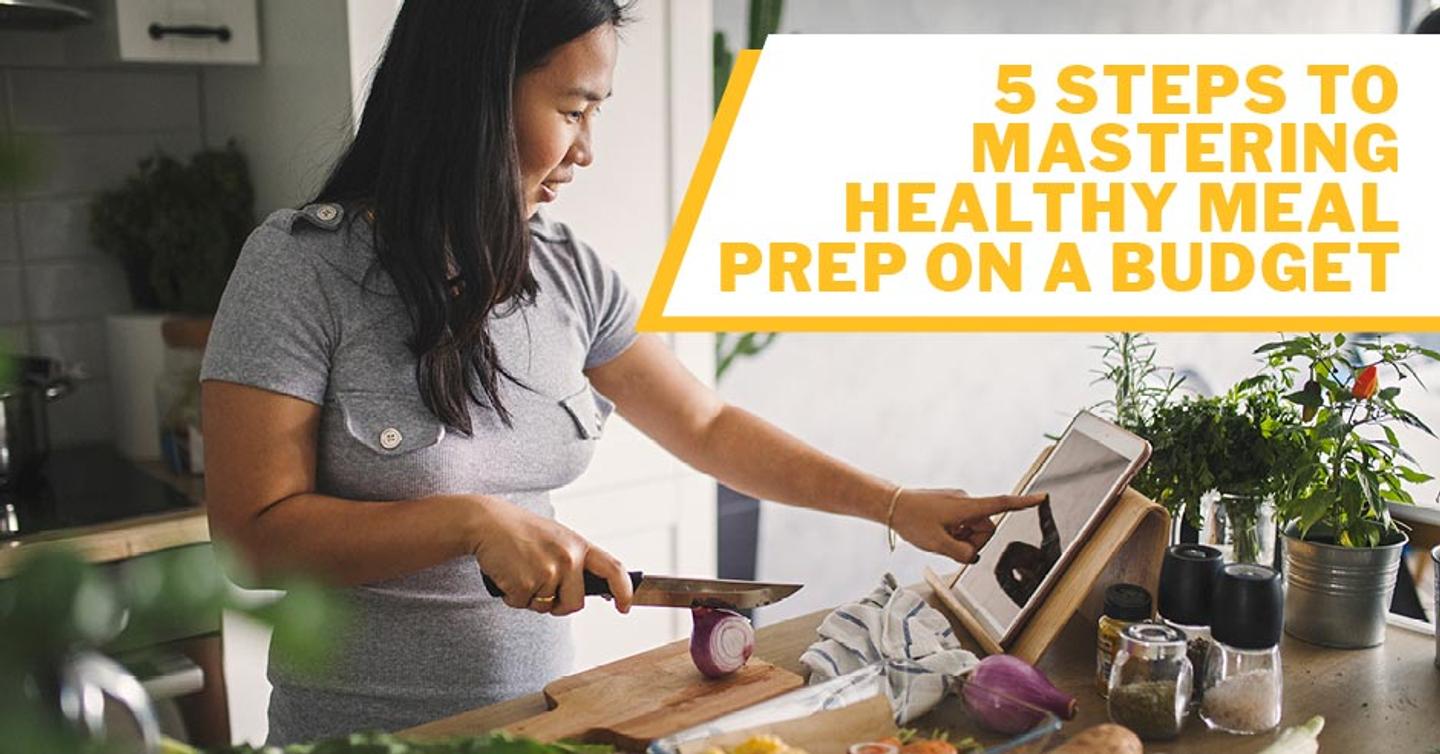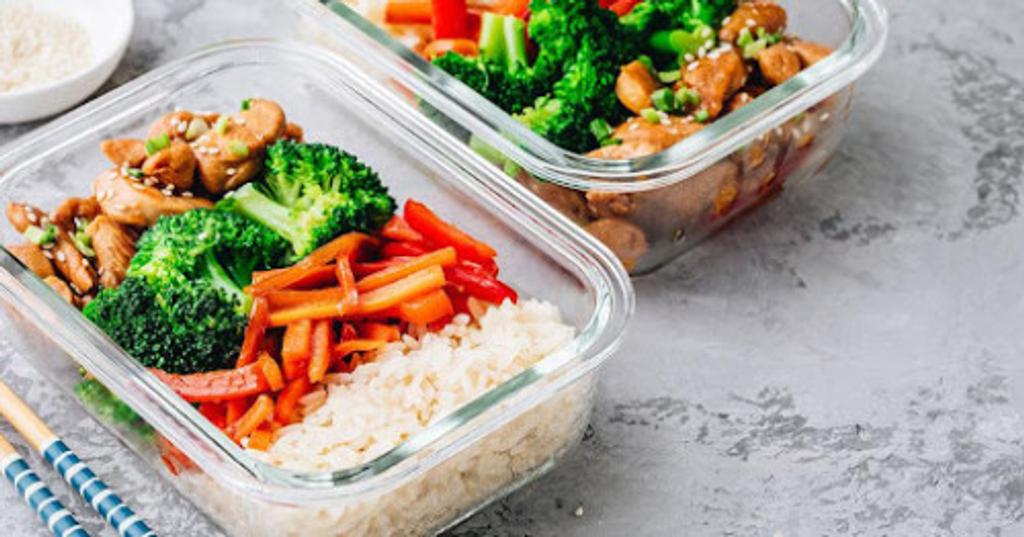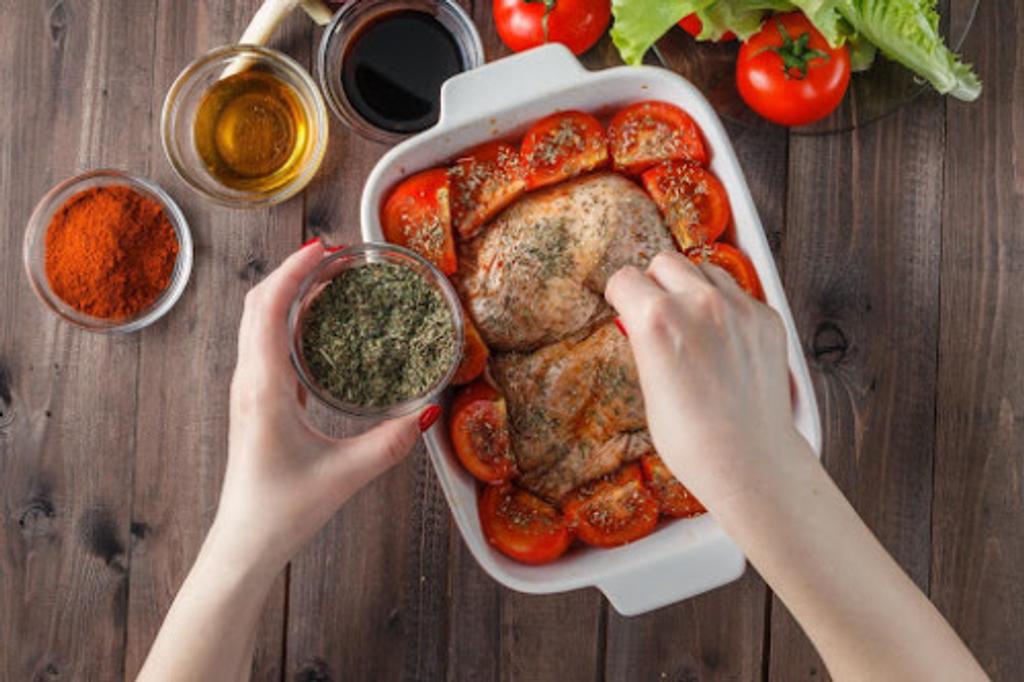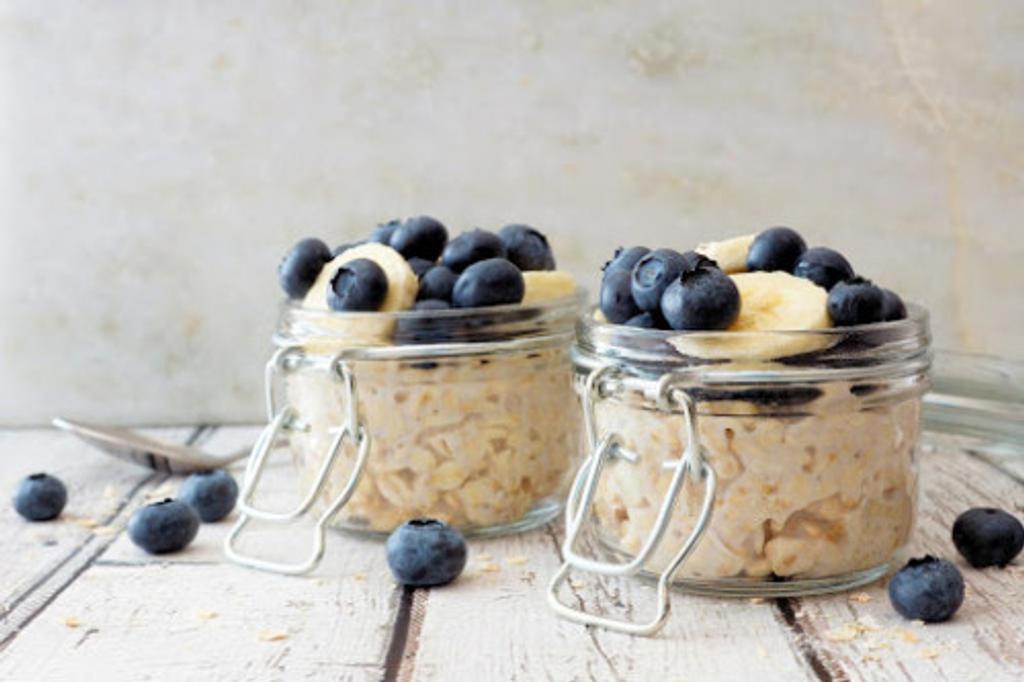
Healthy Meal Prep on a Budget: Expert Tips and Meal Ideas
Reading Time: 15 minutes
BY: ISSA
DATE: 2023-05-16
Have you ever found yourself standing in front of your fridge or pantry, wondering what to have for breakfast, lunch, or dinner? Waiting till the last minute can make it incredibly easy to choose not-so-healthy foods.
If you have a meal plan in place, you can avoid this scenario and stop sabotaging your nutrition. When you prepare ahead of time, you’ll increase the likelihood that you’ll stick to a healthy diet. You wouldn’t go to the gym without headphones, workout shoes, and water, right?
But there's also another benefit of doing some advanced meal prepping. If you do it right, you can actually save yourself quite a bit of cash.
How Meal Planning Leads to Saved Cash
One way meal planning can help you keep more of your hard-earned cash is that it reduces the chances that you'll eat out due to a lack of planning. A healthy meal at a typical fast-food restaurant is usually somewhere between $5 and $10. Order from a sit-down restaurant and you will often pay a higher amount.
Emmie Satrazemis, RD, CSSD, of Trifecta, also reminds us that “eating out constantly burdens not only your wallet but can really rack up unwanted calories in the process. When we eat out, we are usually not choosing the most nutrient-dense options and the meals are often high in fat, sodium, and carbs.”
If you do this just once per week, taking the time to meal plan can save you several hundred dollars per year. Do it more than once a week and you can cut your food-related expenses even more. This is money that you can put back into your budget so it isn't quite so tight. Another option is to put your savings in the bank and have the comfort of a rainy-day fund.
Meal planning also reduces your food waste. Because you've put some thought into it, you can plan your meals in a way where you use the items you have on hand. This limits the items that must be thrown out because they are spoiled or past their safe use date.
Is It Possible to Do Healthy Meal Prep with Limited Monies?
There is a huge misconception that healthy meal planning is impossible when you are on a budget. However, nutritious foods aren't only available to people in a higher financial bracket. You can also plan a healthy, cheap meal if you're somewhat strapped.
The key is to know how to meal prep on a budget, which we'll get into in a moment. But it also involves creating meals that are as satisfying to the taste buds as they are to the wallet. When you enjoy the foods you eat, you're more likely to stick with your plan.
“Remember that a healthy diet is less about bee pollen powder or acai berries, and more about finding basic, nutritious foods that fit your personal health goals. This typically means loading up on simple, whole foods like lean proteins, fruits, vegetables, and whole grains, and cutting back on the more expensive processed foods that are high in added sugars, fats, and artificial ingredients," states Sky Hanka, Functional Nutritionist and Integrative Chef at Trifecta.
5 Steps to Budget Meal Planning
If you're interested in meal prepping in a way that doesn't hurt your budget, follow these five steps.
Step 1: Review Your Fridge and Pantry
One of the biggest ways to waste money is to buy food items you already have at home. That's why the first step to budget meal prepping is to take stock of your fridge and pantry. This keeps you from doubling up on things you don't yet need. It also frees up more monies in your budget to get the things you do.
According to Chef Sky, MS, FMCHC at Trifecta, restaurants practice this same concept and refer to it as ‘FIFO’, First-in-First-out; meaning to shop your fridge and pantry before making your grocery list or planning your recipes for the week.
Step 2: Check Out Local Ads
Most grocery stores still mail out ads, giving local customers a preview of their current sales. Instead of throwing those ads away, take the time to go through them. Look for foods that you can work into your menu plan that week.
Don't feel like you have to stick to your regular grocery store either. Check out the ads for other area supermarkets. It may be worth it to stop at a couple of different locations. Or you may find that your store isn't as cost-friendly as you'd like and you could save more if you started shopping elsewhere.
Step 3: Sign Up for Grocery Store Loyalty Programs
When you sign up for a store's loyalty program, you can download or "clip" coupons directly to your phone. Then, when you check out, the savings are automatically applied to your bill.
Make it a point to review available coupons at least once a week. The last thing you want to do is buy something only to get home and find that you could have got it at a reduced rate had you downloaded the coupon first.
Some stores send extra coupons to people who sign up for rewards. And these coupons are often customized, meaning that they are for items that you typically buy. This provides savings above and beyond what everyone else can get.
Step 4: Come Up with a Meal Plan
After seeing what you have at home, reviewing the ads, and downloading all available coupons for items you normally buy, it's time to come up with meal prep ideas. Create a weekly meal plan that takes all of these into consideration, offering maximum savings.
Maybe you have brown rice in the pantry, but nothing to go with it. Then you notice that chicken thighs are on sale this week and the store has a downloadable coupon for a frozen veggie packet. These all work together to create a healthy, budget-friendly meal.
Step 5: Create Your Grocery Shopping List
Once you've created your meal plan, it's time to write out your grocery shopping list. This ensures that you'll get all of the items you need to follow through with that week's menu. It also minimizes the need to go to the store more often than necessary.
This step is important because research has found that shopping with a list reduces the likelihood that you'll make an impulse purchase (1). These types of purchases make it easy to spend more than you intend. So, the more you can avoid them, the easier it becomes to stay within your desired budget.

Real-World Tips for Mastering Meal Prep on a Budget
Here are more ideas for things you can do to take your meal prepping to the next level.
Have a List of Easy Meal Ideas for Extra Busy Days
Keep on hand a list of easy meal ideas for those days where you know in advance that you're going to be tired and won't want to spend a lot of time in the kitchen. A slow cooker or Instant Pot is good for this purpose. Put your meal in it in the morning before you head out and it's ready to eat when you get home.
Pinterest is Your Friend for Budget Meal Prep Recipes
You can find meal prep recipe recommendations for anything on Pinterest. It is a valuable tool for those who are searching for any type of recipe guide. A friend who adheres to a low-sodium plan is always refreshing and checking their Pinterest account for new ideas—and they always find them. They literally have a catalog of over 200 low-sodium meal recipes, and they never once had to pay for a cookbook.
The same goes for those who follow a low-carb or low-cholesterol diet plan. If you're looking for inexpensive and healthy recipes, you'll definitely find what you're looking for via Pinterest. Lists come at you from every direction and the app allows you to save and search with ease. Pinterest is your friend for finding recipes and meal plans that suit you. There's an endless sea of options out there.
Rachel Blank, Founder and CEO, Allara
Avoid Recipes that Need Special Ingredients
Special ingredients, such as rare spices or exotic fruits, can significantly increase the cost of a meal. Special ingredients can also often go to waste if we do not use them in other recipes.
Avoiding recipes that require these ingredients can help you save money, reduce your food waste, and allow you to stick to your budget. Instead, focus on nutrient-dense foods. Fruits, vegetables, whole grains, and lean proteins are often less expensive than processed or convenience foods. By focusing on these foods, you can plan healthy meals that are also budget friendly.
James Wilkinson, CEO, Balance One Supplements
Strictly Follow the Grocery List
At the grocery store, it's very simple to get distracted, which might cause unwanted purchases and unwanted expenditures.
Try to shop the perimeter (the store's outer edges) first as a general guideline. Whole foods are typically positioned there, increasing your likelihood to add them to your cart first. The more processed items are frequently found near the center of the store. If you find yourself in one of these aisles, turn your gaze upward or downward, rather than straightforward. Often, the priciest things are displayed at eye level.
To assist you with your shopping, you can also download a grocery list app. Some of them even allow you to store your favorite goods and share lists with other consumers. A great approach to make sure you don't forget your list at home is to use an app. Set up a menu. Make a list of the groceries you will need and decide which meals you will prepare for lunch and dinner. You'll be less likely to spend money on fast food or convenience foods.
Joe Li, Managing Director, CheckYa

Plan for Leftovers
No matter what you cook, you'll likely have unused ingredients left over from each meal. Don't throw them away, but think about how to use them. Freezing or reusing in other recipes is the best option. So, every time you cook, plan meals around leftovers. Think about how you can use what is left in future meals.
For example, you can use leftover chicken in a salad or wrap, and vegetables in a soup or stir-fry. If you want to avoid frequent cooking, prepare larger portions to avoid leaving unused ingredients. Store your leftovers in airtight containers in the refrigerator or freezer to make sure they stay fresh and safe to eat. Label them with the date to track how long they have been stored.
Planning for leftovers is integral to healthy meal planning on a limited budget. Not only does it help you save money, but it also saves you time by providing ready-made meals for the next day or two.
Nina Paczka, Community Manager, Resume Now
Cook Like a Chef—from Scratch, No Waste
As someone who has been cooking in professional kitchens since 1997 and as a restaurateur who is mindful of budget, the best way to eat healthy on a budget is to make your food from scratch.
While it is more convenient for meal planning to have individual portions of marinated meats or bags of crispy chickpeas and baby carrots, you are paying a premium for packaging and labor. If you are doing a big meal prep day, you can likely save over a hundred dollars each month or more by just making everything yourself.
Buy bone-in chicken in bulk and divide it into portions with different marinades for your freezer or fridge, roast a can of chickpeas with some spices for a total of $1, and cut and peel your own veggies.
This also gives you more control over fat, salt, and sugar, and you can get more use out of ingredients. Those veggie scraps and chicken bones can make an excellent, nutritious broth loaded with collagen for free.
Paul Kushner, CEO, My Bartender
Let Someone Else Do the Planning
Meal delivery services are convenient, healthy, and often reasonable. Steadily growing in popularity, such companies must compete for your business, which equates to savings!
With a variety of options out there, including vegan, vegetarian, paleo, and more, healthy meals are just a click away. Meal kits include ingredients and recipe cards, while other services provide meals that just need to be popped in the microwave!
In short, signing up for a healthy meal delivery plan can save you both time and money.
Kenneth Lin, CEO, BOOP Bakery
Choose a Nutrient Dense Meal Base
My top tip for healthy meal planning on a limited budget is to use nutrient-rich foods as a base for your meal and then add additional elements to it.
Some examples of cheap and nutrient-dense foods include sweet potatoes, lentils, chicken, and broccoli. If your meal contains a carb like pasta or rice and something that is nutritionally dense, then you are on your way to making a cheap, healthy meal.
You can buy your nutrient-dense foods in bulk quantities. When I'm meal planning on a budget, I center several meals around a certain ingredient, like spinach or black beans, so that I don't have to buy a lot of different ingredients at once.
Dr. Shara Posner, Founder, Back To Health Center
Plant-Based Diet
Incorporating more plant-based meals into your diet is one recommendation from a chef for planning nutritious meals on a tight budget. In general, vegetables, legumes, and grains are less expensive and can be just as nutrient-dense as meat.
To save money, look for seasonal vegetables and buy in quantity whenever you can. To reduce food waste and save time in the kitchen, concentrate on meal preparation and bulk cooking. You can prepare scrumptious, nutritious meals that won't break the bank with a little imagination and preparation.
Rob Smith, Head Chef, Your Private Chef
Free Vegetable Stock
The stalks and tough ends of fresh vegetables like greens, broccoli, asparagus, cauliflower, etc. can be saved and frozen. When you have enough, you can cook it up as stock. It can be as easy as adding salt and water and the cuttings to a pot and simmering for 20 minutes or so.
The resulting stock can be frozen in containers of different sizes. We can then later add the stock to soups, beans, pot roast, or any simmered dish, adding free vitamins, minerals, and taste from what you would normally throw away.
Jeff Zeanah, Owner, Zous Chef

Leverage Seasonings to Make Meals Unique
When meal planning on a budget, it's important to focus on maximizing the potential of your ingredients. It's easy to use low-cost ingredients to pack huge amounts of flavor and variety into meals.
For example, the fitness staples of chicken breast and rice can be seasoned in several ways to elevate the dish, like using ginger and soy to make it more Asian-inspired, or hot sauce and cilantro for a more southwestern flavor.
Swapping out key frozen vegetables can also elevate each meal. Know how to get the most out of the ingredients you can, and find the best value by buying in bulk and cooking in batches. This is how many fitness professionals make sure they're not eating the same, boring meals every day, so they look forward to eating food that helps make the most of their effort in the gym.
Erny Peibst, Founder and CEO, Inside Bodybuilding
Shop the Deals for a Budget Friendly Meal
Healthy meal planning is challenging enough, and it almost seems impossible to do it when on a limited budget. However, being a food-loving father of seven children, who also are food lovers, healthy meal planning is essential.
The best way to go about it is to shop the weekly deals at your favorite stores. Before you plan your weekly meals, look at what's on sale at your go-to stores. Many stores have weekly produce and meat sales, so search for those and make a menu based on what is inexpensive that week.
For example, last week at our grocery store, chicken and broccoli were on sale, so we purchased those items and made grilled chicken stir-fry for a fraction of the cost. If you notice that ground beef is on sale for, say, $2 per pound, purchase enough for multiple meals. You can store this in your freezer, and when you find other healthy items that are on sale, you have a quick, healthy meal, and you save money at the register.
Shawn Hill, Owner, The Grilling Dad
Plan and Buy Whole, Frozen Foods in Bulk and On Sale!
To eat healthy meals on a limited budget, prioritize buying whole, unprocessed foods such as fruits, vegetables, whole grains, and legumes. These foods are very cheap and more nutrient-dense than pre-packaged options.
Use these whole foods with frozen fruits and vegetables to save even more. Plan those meals in advance to prevent impulse purchases and reduce food waste. Finally, buy as much in bulk as you can and look for sales or discounts, and you will eat extremely healthy on a tiny budget.
Michael Hamlin, Personal Trainer, EverFlex Fitness
Prep for the Week on a Sunday and Keep a Spreadsheet
Whenever I'm trying to get my diet in check, I find it much easier to remove decisions from the process and batch cook. I buy ingredients in bulk and prepare ahead of time (on a Sunday, for example), and freeze portions for the upcoming week.
It's much more cost effective from an energy, time, and ingredients perspective than cooking every day. One tip I have is to put together a little spreadsheet (I love spreadsheets!) of ingredients/costs and how many meal portions you get from them, and also record how much you enjoyed them. This will help you identify where you get the best value!
Dave Pedley, Owner and Founder, KnowSheets
Make a Double Batch of Soup
I make a big batch of healthy soup once a week, filled with a lot of inexpensive veggies, like carrots, sweet potatoes, and onions. That way, I always have something quick to eat in the fridge and am not tempted to get fast food when I've had a long day or am starving. This keeps both my healthy eating and budget on track since I'm not tempted by more expensive, unhealthy food.
Laurel Robbins, Founder, Monkeys and Mountains
Go for Store Brands
When I was in college and in bodybuilding, I really had to pay attention to what I ate and make sure it fit into my budget. One very important tip I can give is to always go for store-brand items in the grocery store whenever possible.
Not only are these often cheaper than other brands, but they usually provide the same, if not superior, nutritional quality as well. Prepare meals with minimally processed foods found in the produce aisle, like vegetables, fruits, and lean proteins that are within your budget. That way, you know exactly the quality of food you are eating!
Johar Inam, Project Manager, Solar Panel Installation
Plan Meals Around Whole, In-Season Foods
Buying whole foods that are in season and on sale is a great way to create healthy meals on a budget. This means stocking up on in-season produce, healthful grains, and lean proteins at a discount.
Make your meals revolve around these foods and seek recipes that highlight them. Buying in bulk and storing food in the freezer can be a money- and waste-saving strategy. Meal prepping and bulk cooking are two additional ways to make the most of your time and resources in the kitchen.
Shakzod Khabibov, Founder, Natura Market
Beans and Grains
You can get gigantic bags of grains and dried beans (or canned beans) at Costco or BJ's or even on Amazon, which will last you months and can give you protein, fiber, and a nutrient-dense meal on the cheap.
Simply cook a big batch of the grains once a week and add beans and your favorite condiment. You can add frozen vegetables—which are often cheaper and are usually picked ripe and retain nutrients—to your meal to bump up the fiber and antioxidants of your meal.
Jenny Berk, Founder and CEO, Jenny Eden Berk

Nutrient-Packed Meal Prep Ideas for a Budget Meal Plan
Which food items work well together to make a healthy meal without hurting your budget? Chicken is one. Generally speaking, chicken is usually cheaper than pork or beef. You can save even more if you buy a whole chicken versus buying individual chicken parts.
“Chicken is also one of the best lean protein sources. A 4 oz. skinless breast contains around 26 grams of protein and important minerals such as iron, zinc, riboflavin, niacin, and B6; it’s nutritious and great for easy meal prep,” states Emmie Satrazemis, RD, CSSD from Trifecta.
Throw the chicken in a slow cooker and cover it with chicken stock. Sprinkle it in even amounts of cumin and chili powder. Once it's tender, shred it with a fork and add canned beans. This makes a great white chicken chili that is low in fat but high in taste and nutrition. Throw in some bell pepper and onion for more flavor.
If you prefer chicken breast over the whole chicken, a cheap meal prep idea is to plan for a burrito bowl. Put a little olive oil in a pan and throw in a chicken breast. When it's cooked through, add some taco seasoning and stir it well. At the same time, boil brown rice. Put the brown rice in a bowl and top it with the seasoned chicken. Add a layer of beans (black bean works well) then top it with diced tomatoes and a little bit of cheese.
You can also meal prep breakfast foods, helping you save even more cash. One of the easiest is overnight oats. You make overnight oats in the slow cooker, saving you the time of having to make it in the morning. For best results, use steel-cut oats. If you've never made them, you can find a recipe online.
For a low-cost lunch on the go, make a tuna sandwich on whole wheat or pre-cook some ground turkey or lean ground beef and throw it on a bed of leafy greens. Add chickpea, a vegetable or two (chopped carrots work well), and your favorite salad dressing. Throw it in a meal prep container and take it with you.
An apple with a couple of scoops of peanut butter is a great snack option that doesn't cost a lot. Greek yogurt is another option and one that can usually be found on sale. If you want something sweet, a sweet potato sprinkled with cinnamon is a low-cost way to satisfy this urge.
Learn even more ways help clients build better habits to support their health and wellness goals with ISSA’s Health Coach certification. Health Coaches address obstacles bigger than what can be solved in the gym. They provide the guidance needed to help clients with health conditions, and develop programs that empower these individuals — providing insight, accountability, and motivation to make lasting positive change.
Featured Course
ISSA | Nutritionist
By becoming an ISSA Nutritionist, you'll learn the foundations of how food fuels the body, plus step by step methods for implementing a healthy eating plan into clients' lifestyles.
References
Massara, F., Melara, R.D. & Liu, S.S. Impulse versus opportunistic purchasing during a grocery shopping experience. Mark Lett 25, 361–372 (2014). https://doi.org/10.1007/s11002-013-9255-0